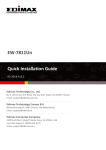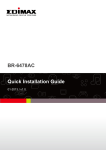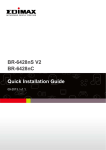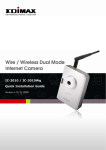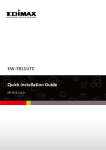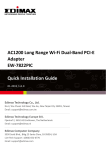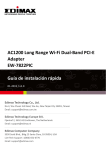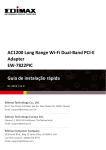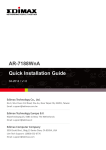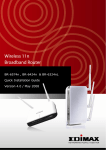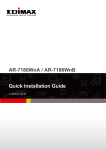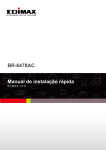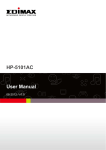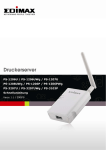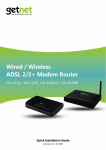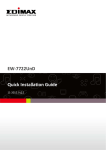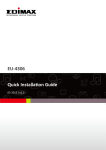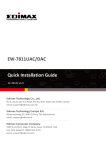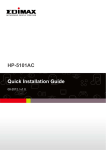Download Edimax EW-7711MAC
Transcript
EW‐7711MAC Quick Installation Guide 03‐2014 / v1.0 1 CONTENTS I. Product Information ............................................................................... 1 I‐1. I‐2. I‐3. Package Contents .................................................................................................................... 1 LED Status ................................................................................................................................ 1 System Requirements .............................................................................................................. 1 II. Installation ............................................................................................. 2 III. Mac ........................................................................................................ 4 III‐1. Driver Installation .................................................................................................................... 4 III‐2. Driver Uninstallation ................................................................................................................ 7 III‐3. Using The Adapter ................................................................................................................... 8 III‐3‐1. Connect to a Wi‐Fi network ..................................................................................................... 8 III‐3‐2. Wireless Utility ....................................................................................................................... 11 III‐3‐2‐1. Profile .................................................................................................................................... 11 III‐3‐2‐2. Link Status ............................................................................................................................. 13 III‐3‐2‐3. Site Survey ............................................................................................................................. 14 III‐3‐2‐4. Statistics ................................................................................................................................ 15 III‐3‐2‐5. WPS ....................................................................................................................................... 16 III‐3‐2‐6. About ..................................................................................................................................... 19 IV. Windows .............................................................................................. 20 IV‐1. IV‐2. IV‐2‐1. IV‐2‐2. IV‐3. Driver Installation .................................................................................................................. 20 Driver Uninstallation .............................................................................................................. 24 Windows XP/Vista/7 .............................................................................................................. 24 Windows 8 ............................................................................................................................. 24 Using The Adapter ................................................................................................................. 25 Multi‐Language Quick Installation Guide (QIG) on the CD Čeština: Českého průvodce rychlou instalací naleznete na přiloženém CD s ovladači. Deutsch: Finden Sie bitte das deutsche S.A.L. beiliegend in der Treiber CD. Español: Incluido en el CD el G.R.I. en Español. Français: Veuillez trouver l’français G.I.R ci‐joint dans le CD. Italiano: Incluso nel CD il Q.I.G. in Italiano. Magyar: A magyar telepítési útmutató megtalálható a mellékelt CD‐n. Nederlands: De nederlandse Q.I.G. treft u aan op de bijgesloten CD. Polski: Skrócona instrukcja instalacji w języku polskim znajduje się na załączonej płycie CD. Português: Incluído no CD o G.I.R. em Portugues. Русский: Найдите Q.I.G. на pусскoм языке на приложеном CD. Türkçe: Ürün ile beraber gelen CD içinde Türkçe Hızlı Kurulum Kılavuzu'nu bulabilirsiniz. Українська: Для швидкого налаштування Вашого пристрою, будь ласка, ознайомтесь з інструкцією на CD. I. Product Information The EW‐7711MAC is a next‐gen 11ac 5GHz USB Wi‐Fi adapter ideal for upgrading MacBooks. This wireless adapter can be used in addition to your existing wireless adapter(s). For help using the adapter after setup, please refer to V. Using The Adapter. I‐1. Package Contents EW‐7711MAC QIG CD‐ROM I‐2. LED Status LED WLAN LED Status On Off Description Wireless activity: transmitting or receiving data. No wireless activity. I‐3. System Requirements ‐ ‐ ‐ ‐ Mac OS X 10.6 ‐ 10.9, Windows XP/Vista/7/8 Minimum USB 2.0 Port Hard Disk: 100MB CD‐ROM Drive 1 LED II. Installation 1. Switch on your computer and insert the USB adapter into an available USB port of your computer. Never use force to insert the USB adapter. 2. Insert the included CD‐ROM into the CD drive of your computer. The setup wizard is also available for download from the Edimax website. 3. The setup wizard will open. Mac users double click “Edimax.dmg” and Windows users click the EW‐7711MAC adapter. 2 4. Please follow the instructions in the appropriate chapter for your operating system: III. IV. Mac Windows 3 III. Mac III‐1. Driver Installation 1. Double click the “AC450_USB‐Install.pkg” file to open the driver installation wizard. 2. Click “Continue” to proceed to the next step. 4 3. Click “Install” to install the driver. 4. You may be prompted to enter your system/administrative password before the installation can begin. Enter your password and click “Install Software”. 5. You will be prompted that you must restart your computer when the installation is complete. Click “Continue Installation” to proceed. 5 6. Please wait while the driver is installing. 7. When the installation is complete, you will see the following screen informing you that “The installation was successful”. Click “Restart” to restart your computer. 6 8. After your system has restarted, the wireless utility will open automatically as shown below. You can use the wireless utility to connect to a Wi‐Fi network with your new adapter. 9.Select a Wi‐Fi network from the list and click “Connect”. For more guidance, please refer to III‐3. Using The Adapter. III‐2. Driver Uninstallation 1.Double click the “Edimax.dmg” on the included CD wizard. 7 2.Double click the “AC450_USB‐Uninstall.pkg” file to open the driver un‐ installation wizard and follow the instructions on‐screen. III‐3. Using The Adapter Mac users need to connect to a Wi‐Fi network using the included utility software. III‐3‐1. Connect to a Wi‐Fi network 1. If the wireless utility software window shown below is not already open, please click the “E” icon in the top right of the screen and select “Open Wireless Utility”. 8 2. Select “Site Survey” from the menu across the top of the window, and then select a 5GHz Wi‐Fi network from the list and click “Connect”. 3. If you set a password for your network, you will then be prompted to enter it. Enter your password and click “OK”. 9 4. After correctly entering your password, you will be successfully connected to your Wi‐Fi network. 10 III‐3‐2. Wireless Utility The wireless utility offers features to monitor and configure your connection. Navigate the wireless utility using the menu across the top of the window. III‐3‐2‐1. Profile The “Profile” screen allows you to save different Wi‐Fi connection settings as “Profiles”. Existing profiles are listed in the “Profile List”. Opens a new window to add a new profile. Edit an existing profile. Delete an existing profile. Activate (connect to) an existing profile. ADD EDIT DELETE ACTIVATE ADD When you select “ADD”, a new window will open. Select an SSID from the drop‐down menu in the top right corner, or enter a “Profile Name”, then go the “Authentication & Security” tab and enter the Wi‐Fi network’s security key/password under “WPA Pre‐Shared Key”. You can also add a new profile from the “Site Survey” screen. 11 Power Saving Mode Select “CAM (Constantly Awake Mode)” or “Power Saving Mode” depending on your preference. In “Power Saving Mode” the device will automatically reduce its power consumption when not being used. Tx Power Specify a Tx power level. This adjusts the transmit power of the wireless adapter. A lower level reduces performance but decreases interference in the local network environment. RTS Threshold Adjust the RTS threshold value. Fragment Threshold Adjust the fragment threshold value. It is recommended to keep the default values for the other settings on this page. Advanced users can make adjustments if necessary. 12 III‐3‐2‐2. Link Status The “Link Status” page displays information about the current wireless connection. Turn Radio OFF Switch off the adapter’s wireless radio. 13 III‐3‐2‐3. Site Survey The “Site Survey” screen displays a list of all available Wi‐Fi networks within range along with various categories of information about each network. RESCAN CONNECT ADD PROFILE Refresh the list of available wireless networks Connect to a selected wireless network. Use a selected wireless network to create a new profile (see III‐3‐2‐1. Profile). 14 III‐3‐2‐4. Statistics The “Statistics”page displays transmit and receive statistics about the wireless connection. RESET COUNTER Resets all counters to zero. 15 III‐3‐2‐5. WPS Wi‐Fi Protected Setup is a simple, alternative way to establish connections between WPS compatible devices. Some wireless network devices feature a built‐in WPS button, which activates WPS on that device. When WPS is activated in the correct manner and at the correct time for two compatible devices, they will automatically connect to each other. WPS can also be activated via a device’s web user interface, which has the same effect as physically pushing the WPS button (known as PBC or “push button configuration”). PIN code WPS is an additional variation of WPS which can be activated from a device’s web user interface, and includes the use of a PIN code between the two devices for identification and verification. The “WPS” page displays information about Wireless Protected Setup (WPS), including a list of available WPS access points and user‐defined WPS “Profiles”. Instructions to set up PBC WPS and PIN code WPS are included below, followed by a description of each item on this page: You can save WPS settings as a profile using the “Export Profile” button and switch between profiles using the “WPS Profile List”. 16 PBC: Push Button Configuration The EW‐7711MAC does not feature a physical WPS button, but PBC WPS can be executed from this page by following the steps below: 1. Press the WPS button on your wireless router/access point for the correct length of time to activate its WPS. Please check the instructions for your wireless device for how long you need to hold down its WPS button to activate WPS. 2. Within two minutes, click the “PBC” button in the bottom left of the “WPS” page. The wireless adapter will establish a connection with your wireless router/access point. PIN Code WPS PIN code WPS includes the additional use of a PIN code between devices. This is useful for identification and verification purposes in crowded wireless environments with multiple routers/access points/wireless devices. 1. The wireless adapter’s PIN code is listed on the right side of the “WPS” page under “Pin Code”. Go to your wireless router/access point’s web user interface and input the wireless adapter’s PIN code in the correct location, and activate PIN code WPS for your wireless router/adapter. Please check the instructions for your wireless router/access point for how to access the web user interface and where to input the PIN code. 17 2. Within two minutes, select your wireless/router/access point from the “WPS AP” list as shown below, and then click the “PIN” button in the bottom left of the “WPS” page. The wireless adapter will establish a connection with your wireless router/access point. Below is a description of all the items on the “WPS” page: Rescan Refresh the list of available wireless networks. Information Display more information about the selected wireless network. Pin Code Renew Generate a new PIN code for WPS PIN code setup. Config Mode Enrollee “Enrollee” means the device acts a wireless client and will follow the settings of the wireless router/access point. This is the default setting. Registrar “Registrar” means the other WPS device will follow the settings of the wireless adapter. Enrollee mode (above) is recommended. Profile Detail Show details of selected WPS profile. Connect Connect to selected WPS profile. Rotate Rotate WPS profile. Disconnect Disconnect from selected WPS profile. 18 Export Profile Delete PIN PBC Save current WPS settings as a profile. Delete selected WPS profile. Begin PIN code WPS with selected access point. Begin Push Button Configuration WPS. III‐3‐2‐6. About The “About” screen displays various information such as wireless utility version and driver version. 19 IV. Windows IV‐1. Driver Installation 1. Click the EW‐7711MAC wireless USB adapter to continue. 2. Click “Install Driver” to continue to install the drivers for your EW‐ 7711MAC. 20 3.Please wait while the setup wizard prepares to install the drivers. 4. Click “Next” to continue. 5. Click “Install” to install the driver. 21 6. Please wait while the driver is installing. 7. When the installation is complete, click “Finish”. 22 8. Click “Exit” to close the setup wizard. The multi‐language QIG is also included on the CD‐ROM. To open it click “Multi‐language QIG”. 9.Windows users can connect to an available Wi‐Fi network as usual. For guidance on doing so, please refer to IV‐3. Using The Adapter. 23 IV‐2. Driver Uninstallation IV‐2‐1. Windows XP/Vista/7 1. Go to Start > Programs > Edimax Wireless LAN > Uninstall. 2. Follow the on screen instructions. An uninstall wizard will guide you through the process. IV‐2‐2. Windows 8 1. Right click anywhere on the “Start” screen and then click the “All apps” icon in the bottom right corner. 2. Locate the Edimax Wireless LAN category, select “Uninstall” and follow the on‐screen instructions. 24 IV‐3. Using The Adapter After you have installed the driver, Windows users can connect to a Wi‐Fi network as usual. Below is an example of how to connect using Windows Vista ‐ the process may vary slightly for other versions of Windows. 1. Click the network icon (examples below) in the system tray and select “Connect to a network”. 2. Your new wireless adapter will be listed in addition to your existing wireless adapter. In the example below, it is named “Wireless Network Connection 3”. Search for the SSID of your 5GHz Wi‐Fi network and then click “Connect”. If you set a password for your network, you will then be prompted to enter it. 25 3. After correctly entering your password, you will be successfully connected to your Wi‐Fi network. You can disconnect the wireless adapter in the same way you usually would for your existing wireless adapter. 26 COPYRIGHT Copyright © Edimax Technology Co., Ltd. all rights reserved. No part of this publication may be reproduced, transmitted, transcribed, stored in a retrieval system, or translated into any language or computer language, in any form or by any means, electronic, mechanical, magnetic, optical, chemical, manual or otherwise, without the prior written permission from Edimax Technology Co., Ltd. Edimax Technology Co., Ltd. makes no representations or warranties, either expressed or implied, with respect to the contents hereof and specifically disclaims any warranties, merchantability, or fitness for any particular purpose. Any software described in this manual is sold or licensed as is. Should the programs prove defective following their purchase, the buyer (and not this company, its distributor, or its dealer) assumes the entire cost of all necessary servicing, repair, and any incidental or consequential damages resulting from any defect in the software. Edimax Technology Co., Ltd. reserves the right to revise this publication and to make changes from time to time in the contents hereof without the obligation to notify any person of such revision or changes. The product you have purchased and the setup screen may appear slightly different from those shown in this QIG. The software and specifications are subject to change without notice. Please visit our website www.edimax.com for updates. All brand and product names mentioned in this manual are trademarks and/or registered trademarks of their respective holders. Federal Communication Commission Interference Statement This equipment has been tested and found to comply with the limits for a Class B digital device, pursuant to Part 15 of FCC Rules. These limits are designed to provide reasonable protection against harmful interference in a residential installation. This equipment generates, uses, and can radiate radio frequency energy and, if not installed and used in accordance with the instructions, may cause harmful interference to radio communications. However, there is no guarantee that interference will not occur in a particular installation. If this equipment does cause harmful interference to radio or television reception, which can be determined by turning the equipment off and on, the user is encouraged to try to correct the interference by one or more of the following measures: 1. Reorient or relocate the receiving antenna. 2. Increase the separation between the equipment and receiver. 3. Connect the equipment into an outlet on a circuit different from that to which the receiver is connected. 4. Consult the dealer or an experienced radio technician for help. FCC Caution This device and its antenna must not be co‐located or operating in conjunction with any other antenna or transmitter. This device complies with Part 15 of the FCC Rules. Operation is subject to the following two conditions: (1) this device may not cause harmful interference, and (2) this device must accept any interference received, including interference that may cause undesired operation. Any changes or modifications not expressly approved by the party responsible for compliance could void the authority to operate equipment. Federal Communications Commission (FCC) Radiation Exposure Statement This equipment complies with FCC radiation exposure set forth for an uncontrolled environment. In order to avoid the possibility of exceeding the FCC radio frequency exposure limits, human proximity to the antenna shall not be less than 2.5cm (1 inch) during normal operation. Federal Communications Commission (FCC) RF Exposure Requirements This EUT is compliance with SAR for general population/uncontrolled exposure limits in ANSI/IEEE C95.1‐1999 and had been tested in accordance with the measurement methods and procedures specified in OET Bulletin 65 Supplement C. The equipment version marketed in US is restricted to usage of the channels 1‐11 only. This equipment is restricted to indoor use when operated in the 5.15 to 5.25 GHz frequency range. R&TTE Compliance Statement This equipment complies with all the requirements of DIRECTIVE 1999/5/EC OF THE EUROPEAN PARLIAMENT AND THE COUNCIL of March 9, 1999 on radio equipment and telecommunication terminal equipment and the mutual recognition of their conformity (R&TTE). The R&TTE Directive repeals and replaces in the directive 98/13/EEC (Telecommunications Terminal Equipment and Satellite Earth Station Equipment) As of April 8, 2000. Safety This equipment is designed with the utmost care for the safety of those who install and use it. However, special attention must be paid to the dangers of electric shock and static electricity when working with electrical equipment. All guidelines of this and of the computer manufacture must therefore be allowed at all times to ensure the safe use of the equipment. EU Countries Intended for Use The ETSI version of this device is intended for home and office use in Austria, Belgium, Bulgaria, Cyprus, Czech, Denmark, Estonia, Finland, France, Germany, Greece, Hungary, Ireland, Italy, Latvia, Lithuania, Luxembourg, Malta, Netherlands, Poland, Portugal, Romania, Slovakia, Slovenia, Spain, Sweden, Turkey, and United Kingdom. The ETSI version of this device is also authorized for use in EFTA member states: Iceland, Liechtenstein, Norway, and Switzerland. EU Countries Not Intended for Use None. EU Declaration of Conformity English: This equipment is in compliance with the essential requirements and other relevant provisions of Directive 1999/5/EC, 2009/125/EC. Français: Cet équipement est conforme aux exigences essentielles et autres dispositions de la directive 1999/5/CE, 2009/125/CE. Čeština: Toto zařízení je v souladu se základními požadavky a ostatními příslušnými ustanoveními směrnic 1999/5/ES, 2009/125/ES. Polski: Urządzenie jest zgodne z ogólnymi wymaganiami oraz szczególnymi warunkami określonymi Dyrektywą UE 1999/5/EC, 2009/125/EC. Română: Acest echipament este în conformitate cu cerințele esențiale şi alte prevederi relevante ale Directivei 1999/5/CE, 2009/125/CE. Русский: Это оборудование соответствует основным требованиям и положениям Директивы 1999/5/EC, 2009/125/EC. Magyar: Ez a berendezés megfelel az alapvető követelményeknek és más vonatkozó irányelveknek (1999/5/EK, 2009/125/EC). Türkçe: Bu cihaz 1999/5/EC, 2009/125/EC direktifleri zorunlu istekler ve diğer hükümlerle ile uyumludur. Українська: Обладнання відповідає вимогам і умовам директиви 1999/5/EC, 2009/125/EC. Slovenčina: Toto zariadenie spĺňa základné požiadavky a ďalšie príslušné ustanovenia smerníc 1999/5/ES, 2009/125/ES. Deutsch: Dieses Gerät erfüllt die Voraussetzungen gemäß den Richtlinien 1999/5/EC, 2009/125/EC. Español: El presente equipo cumple los requisitos esenciales de la Directiva 1999/5/EC, 2009/125/EC. Italiano: Questo apparecchio è conforme ai requisiti essenziali e alle altre disposizioni applicabili della Direttiva 1999/5/CE, 2009/125/CE. Nederlands: Dit apparaat voldoet aan de essentiële eisen en andere van toepassing zijnde bepalingen van richtlijn 1999/5/EC, 2009/125/EC. Português: Este equipamento cumpre os requesitos essênciais da Directiva 1999/5/EC, 2009/125/EC. Norsk: Dette utstyret er i samsvar med de viktigste kravene og andre relevante regler i Direktiv 1999/5/EC, 2009/125/EC. Svenska: Denna utrustning är i överensstämmelse med de väsentliga kraven och övriga relevanta bestämmelser i direktiv 1999/5/EG, 2009/125/EG. Dansk: Dette udstyr er i overensstemmelse med de væsentligste krav og andre relevante forordninger i direktiv 1999/5/EC, 2009/125/EC. Suomi: Tämä laite täyttää direktiivien 1999/5/EY, 2009/125/EY oleelliset vaatimukset ja muut asiaankuuluvat määräykset. ‐‐‐‐‐‐‐‐‐‐‐‐‐‐‐‐‐‐‐‐‐‐‐‐‐‐‐‐‐‐‐‐‐‐‐‐‐‐‐‐‐‐‐‐‐‐‐‐‐‐‐‐‐‐‐‐‐‐‐‐‐‐‐‐‐‐‐‐‐‐‐‐‐‐‐‐‐‐‐‐‐‐‐‐‐‐‐‐‐‐‐‐‐‐‐‐‐‐‐‐‐‐‐‐‐‐‐‐‐‐‐‐‐‐‐‐‐‐‐ WEEE Directive & Product Disposal At the end of its serviceable life, this product should not be treated as household or general waste. It should be handed over to the applicable collection point for the recycling of electrical and electronic equipment, or returned to the supplier for disposal. Declaration of Conformity We, Edimax Technology Co., Ltd., declare under our sole responsibility, that the equipment described below complies with the requirements of the European R&TTE directives. Equipment: AC450 Wi‐Fi USB Adapter – 11ac upgrade for MacBook Model No.: EW‐7711MAC The following European standards for essential requirements have been followed: Directives 1999/5/EC Spectrum : EMC : Safety (LVD) : ETSI EN 301 893 V1.7.1 (2012-06) EN 301 489-1 V1.9.2 (2011-09); EN 301 489-17 V2.2.1 (2012-09) IEC 60950-1:2005 (2nd Edition); Am 1:2009; EN 60950-1:2006+A11:2009+A1:2010+A12:2011 Recommendation 99/519/EC EMF : EN 62311:2008 Directives 2006/95/EC Safety (LVD) : IEC 60950-1:2005 (2nd Edition); Am 1:2009; EN 60950-1:2006+A11:2009+A1:2010+A12:2011 Edimax Technology Co., Ltd. No. 3, Wu Chuan 3rd Road, Wu‐Ku Industrial Park, New Taipei City, Taiwan Date of Signature: March 4th, 2014 Signature: Printed Name: Title: Albert Chang Director Edimax Technology Co., Ltd.



































